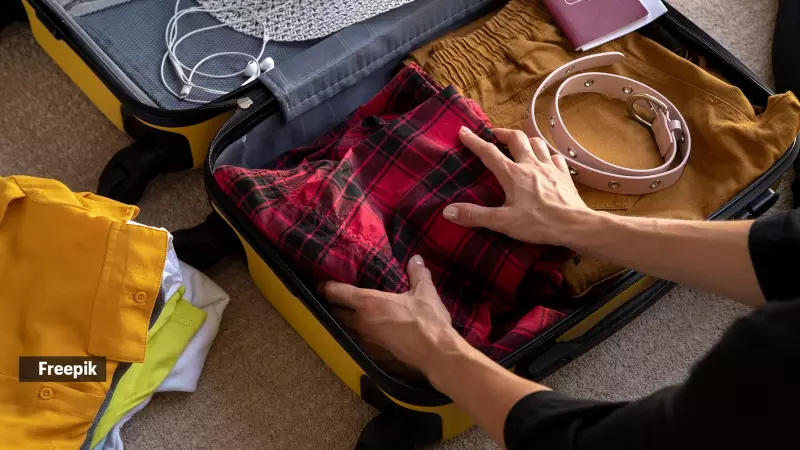
Does the thought of packing for your next holiday fill you with dread? The challenge of fitting multiple dresses, shirts, bottoms, shoes and accessories into a single suitcase can be overwhelming for even the most experienced travelers. Fortunately, digital creator Shashank Arora has come to the rescue with a practical test of three popular packing methods that promise to make travel lighter and more organized.
The Great Packing Experiment: Three Methods Put to Test
In a recent social media post that has captured travelers' attention, Shashank Arora decided to settle the long-standing debate about the best packing method once and for all. He conducted a controlled experiment using one small bag and identical sets of clothing to compare three different folding techniques. The results might surprise you and could change how you pack for your next adventure.
Method 1: The Traditional Fold
The conventional folding method that most of us grew up with proved surprisingly effective in Arora's test. Using this technique, he managed to fit an impressive collection of items: 5 shirts, 4 t-shirts, 3 pants (including 2 jeans and 1 formal trouser), 2 towels, and 2 shorts, along with shoes, socks, slippers, and boxers. The significant advantage of this method was that everything remained neat and easily accessible throughout the journey.
Method 2: The Viral Vertical Packing Technique
The vertical packing method, which involves stacking clothes upright instead of laying them flat, has been trending across social media platforms. While it's often promoted as a space-saving miracle, Arora's experiment revealed some limitations. The method only allowed for one extra shirt compared to traditional folding. More importantly, it requires a taller suitcase since the technique consumes more vertical space. The approach also proved problematic for formal clothing, with wrinkles and crushed collars guaranteed according to the test results.
Method 3: The Rolling Method
Rolling every item—from shirts and pants to towels—has been another popular packing hack among frequent travelers. While this technique did save some space, Arora found it to be time-consuming and less organized in appearance. The method works best for casual clothing like t-shirts and jeans but falls short when dealing with structured garments that require careful handling.
Expert Weighs In: What Really Works Best?
According to costume designer Shilpa GNS, who shared her professional perspective on packing techniques, no single method fits all situations. However, she noted that the traditional fold method generally performs best for keeping clothes clean and relatively wrinkle-free. Her expert recommendation is to customize your approach by switching between methods depending on your clothing types.
"Rolling thinner clothes and folding the heavier ones offers the most space inside the suitcase overall," Shilpa GNS advised. This hybrid approach allows travelers to maximize their packing efficiency while minimizing clothing damage.
The Viral 5-4-3-2-1 Packing Rule
Beyond the folding technique itself, many travelers struggle with deciding what to pack. This is where the viral 5-4-3-2-1 method comes in handy as a practical guideline for creating the perfect travel wardrobe without overpacking.
5 Pieces of Clothing: Limit yourself to five essential clothing items that are versatile and suitable for different occasions. This could include a combination of casual wear, one or two dressier outfits, and weather-appropriate layers. For example, you might pack a pair of jeans, two tops, a sweater, and a dress that can be mixed and matched to create multiple outfits.
4 Pairs of Shoes: Since footwear consumes significant suitcase space, choose wisely. Stick to four pairs that meet your activity needs—typically including comfortable walking shoes, dress shoes, sandals, and sneakers. Ensure they're appropriate for your destination's climate and planned activities.
3 Accessories: Select three versatile accessories that can elevate your outfits without occupying much space. This might include a scarf, belt, hat, crossbody bag, or sunglasses that complement multiple outfits.
2 Bathing Suits or Specialty Items: Depending on your destination, pack just two specialty items. For beach vacations, this could mean swimsuits and cover-ups; for active trips, workout gear and appropriate jackets.
1 Wildcard Item: Allow yourself one extra item that doesn't fit other categories but will enhance your trip. This could be a book for downtime, a special event outfit, or something specific to your destination that adds personal touch to your journey.
Whether you're planning a weekend getaway or an extended vacation, these tested packing methods and the structured 5-4-3-2-1 approach can transform your travel preparation from stressful to seamless. The key is finding what works best for your specific needs and destination requirements.





